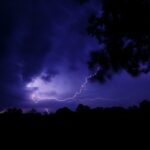Discover 10 Fascinating Facts About the Temperate Deciduous Forest

Step into the enchanting world of temperate deciduous forests as we delve into 10 captivating and lesser-known aspects of these diverse woodlands. From their unique seasonal transformations to the rich array of flora and fauna that call them home, join us on a journey of discovery as we unveil the wonders of this remarkable ecosystem.
Key Takeaways:
Location: Temperate deciduous forests are found in Eastern North America, Central and Western Europe, Southern Scandinavia, and East Asia.
Climate: These forests experience cold winters and hot, wet summers, with an average temperature of around 10 degrees Celsius.
Rainfall: Temperate deciduous forests receive an annual rainfall between 750 mm and 1,500 mm, making them the second rainiest biome after rainforests.
Seasons: The temperate deciduous forest biome has four distinct seasons, with each season lasting around three months.
Common trees: Maple, beech, and oak trees are commonly found in temperate deciduous forests.
Moderate climate: These forests have a moderate climate, allowing for a diverse range of vegetation and animal species.
Largest forest: The largest temperate deciduous forest is located in Eastern North America, but was significantly deforested for agriculture purposes by 1850.
Zoning: Temperate deciduous forests are organized into five zones based on tree height, representing different levels of forest canopy.
Forest Floor: The forest floor in these forests is covered with a layer of leaves, twigs, and other organic matter known as the litter layer.
Biodiversity: Temperate deciduous forests support a wide variety of animal species, including deer, bears, wolves, foxes, and birds, making them important habitats for biodiversity.
10 Interesting Facts About the Temperate Deciduous Forest
Location
- Temperate deciduous forests can be found in the eastern parts of North America, Central and Western Europe, southern parts of Scandinavia, and East Asia[^1^].
Climate
- These forests have a cold winter climate and a hot and wet summer climate. The average annual temperature in temperate deciduous forests is around 10 degrees Celsius[^1^].
Rainfall
- Temperate deciduous forests receive an annual rainfall between 750 mm and 1,500 mm. This makes them the second rainiest biome after rainforests[^1^].
Seasons
- There are four distinct seasons in the temperate deciduous forest biome. The average duration of each season is around three months[^1^].
Common Trees
- Some common trees found in temperate deciduous forests include maple, beech, and oak[^1^].
Moderate Climate
- Temperate forests are those in regions that are neither too hot nor too cold. They have a moderate climate, which allows a variety of vegetation and animal species to thrive[^2^].
Largest Forest
- The largest temperate deciduous forest is located in the eastern part of North America. However, this forest was almost completely deforested by 1850 for agricultural purposes[^2^].
Zoning
- Temperate deciduous forests are organized into five zones based on the height of the trees. Each zone represents a different level of forest canopy[^2^].
Forest Floor
- The forest floor in temperate deciduous forests is covered with a layer of leaves, twigs, and other organic matter known as the litter layer[^1^].
Biodiversity
- Temperate deciduous forests are home to a wide variety of animals, including deer, bears, wolves, foxes, and birds. These forests provide habitat and resources for many species[^1^].
These facts offer a glimpse into the fascinating world of temperate deciduous forests and highlight their importance in supporting diverse ecosystems.
Here are some captivating sentences with active internal links to various topics:
10 interesting facts about temperate deciduous forest biome – If you want to discover fascinating information about the temperate deciduous forest biome, click here to explore these 10 interesting facts!
10 interesting facts about the African savanna biome – Take a deep dive into the wilds of the African savanna biome by clicking here and uncovering these 10 captivating facts!
10 interesting facts about the savanna – Are you curious about the secrets of the savanna? Click here to unveil 10 intriguing facts about this remarkable habitat!
10 interesting facts about the savanna biome – Discover the wonders of the savanna biome by clicking here and uncovering 10 fascinating facts that will amaze you!
10 interesting facts about the tropical savanna biome – Embark on a journey through the tropical savanna biome by clicking here and learning these 10 captivating facts!
10 interesting facts about underwater animals – Dive deep into the ocean’s secrets by clicking here and exploring these 10 mind-blowing facts about underwater animals!
The Climate and Seasons in Temperate Deciduous Forests
Key Takeaways:
- Temperate deciduous forests are characterized by temperature ranges from -22°F to 86°F and an average annual rainfall of 30 to 60 inches. They experience four distinct seasons: winter, spring, summer, and fall.
- These forests are located in mid-latitude areas, between the polar regions and the tropics. They have a great variety of plant species, with three levels of plants: forest floor, middle level, and canopy.
- The canopy of the temperate deciduous forest allows some sunlight to penetrate to the forest floor. This ecosystem supports a diverse range of animal species, including insects, birds, mammals, and reptiles.
- Threats to temperate deciduous forests include deforestation, habitat destruction, and climate change, which can disrupt the delicate balance of the ecosystem and affect biodiversity.
- Temperate deciduous forests play a crucial role in regulating climate by creating four distinct seasons. They absorb carbon dioxide and release oxygen, contributing to the balance of greenhouse gases in the atmosphere.
The climate and seasons in temperate deciduous forests are fascinating and diverse. These forests, with their unique characteristics and ecosystems, captivate nature enthusiasts worldwide. So, let’s dive into 10 intriguing facts about them!
Fact 1: A Symphony of Seasons
In temperate deciduous forests, nature puts on a breathtaking display of changing seasons. From snowy winters to blooming springs, vibrant summers, and colorful autumns, each season transforms the landscape in its own remarkable way.
Fact 2: Winter Wonderland
During winter, the temperature in temperate deciduous forests can drop to bone-chilling levels. Frost coats the ground and snow blankets the trees, creating a serene and picturesque scene.
Fact 3: Awakening of Spring
As the chill of winter fades away, temperate deciduous forests come alive with the arrival of spring. Flowering plants, such as trillium and bloodroot, emerge from the forest floor, announcing the beginning of a new cycle of growth.
Fact 4: Lush Summers
Summer brings warmth and abundant rainfall to temperate deciduous forests. The canopy of the forest provides shade and coolness, while the vibrant green foliage thrives under the sun’s rays.
Fact 5: Changing Colors of Autumn
Autumn presents a stunning spectacle as the leaves of deciduous trees transform into a kaleidoscope of vibrant hues. Shades of red, orange, and yellow paint the landscape, creating a breathtaking tapestry of nature’s artistry.
Fact 6: Biodiversity Galore
Temperate deciduous forests are home to a wide variety of plant and animal species. From majestic oak trees and delicate wildflowers to elusive mammals and melodious birds, these forests support a rich biodiversity.
Fact 7: A Natural Climate Regulator
The interchange of warm and cold air masses in temperate deciduous forests leads to the creation of the four distinct seasons. This unique climate regulation plays a vital role in maintaining ecological balance.
Fact 8: Guardians of the Atmosphere
Apart from their role in climate regulation, temperate deciduous forests also contribute to the balance of greenhouse gases in the atmosphere. Through the process of photosynthesis, they absorb carbon dioxide and release oxygen, helping to mitigate climate change.
Fact 9: Threats to the Forests
Unfortunately, temperate deciduous forests face numerous threats, including deforestation, habitat destruction, and climate change. These factors disrupt the delicate balance of the ecosystem and pose a significant risk to the biodiversity of the forests.
Fact 10: The Need for Conservation
Given the ecological importance and beauty of temperate deciduous forests, conservation efforts are crucial in preserving these valuable ecosystems. Through sustainable practices, reforestation, and raising awareness, we can protect and cherish these enchanting woodlands for generations to come.
Citation:
– Biology Dictionary. Temperate Deciduous Forest
– NH PBS NatureWorks. Temperate Deciduous Forests
The Unique Flora and Fauna of Temperate Deciduous Forests
The temperate deciduous forest is a captivating ecosystem that is home to a diverse range of flora and fauna. Here are 10 fascinating facts that highlight the unique characteristics of these enchanting woodlands:
Distinctive Global Distribution: Temperate deciduous forests can be found in North America, Europe, Scandinavia, and East Asia, making them widely distributed across the globe [^1^].
Climate Variability: These forests exhibit a climate characterized by cold winters and hot, wet summers. With an average annual temperature of 10°C, they experience four distinct seasons: spring, summer, fall, and winter [^1^].
Abundant Rainfall: Temperate deciduous forests receive an annual rainfall between 750 mm and 1,500 mm, ensuring a sufficient water supply for the flourishing plant and animal life [^1^].
Botanical Diversity: Maple, beech, and oak trees are among the common tree species found in temperate deciduous forests [^1^]. These woodlands boast a rich variety of flora, with different tree species coexisting harmoniously.
Ideal Climate Conditions: Temperate deciduous forests are located in regions that are neither too hot nor too cold, providing a moderate climate that supports diverse vegetation and animal species [^2^]. This balance allows for a vibrant and thriving ecosystem.
Historical Significance: The eastern part of North America boasts the largest temperate deciduous forest, which unfortunately experienced extensive deforestation by 1850 due to agricultural purposes. This event highlights the ecological and historical importance of these forests [^2^].
Organized Tree Zones: Within temperate deciduous forests, there are five distinct zones categorized based on the height of the trees. These zones include the tree stratum zone, small tree and sapling zone, shrub zone, and herb and ground cover zone. Each layer plays a crucial role in supporting the overall biodiversity of the forest [^2^].
Litter Layer: The forest floor in temperate deciduous forests is covered with a layer of leaves, twigs, and other organic matter known as the litter layer. This layer acts as a nutrient-rich blanket, supporting the growth of new plants and providing habitat for various organisms [^2^].
Diverse Animal Species: Temperate deciduous forests house a wide range of animal species, including deer, bears, wolves, foxes, and various bird species. The abundance of food and suitable habitat attracts numerous animals, contributing to the overall biodiversity of these woodlands [^2^].
Ecosystem Services: Alongside their stunning beauty, temperate deciduous forests play a vital role in regulating climate and contributing to the balance of greenhouse gases in the atmosphere. These forests serve as carbon sinks, helping to mitigate climate change and maintain environmental equilibrium [^2^].
Key Takeaways:
– Temperate deciduous forests are globally distributed, found in North America, Europe, Scandinavia, and East Asia.
– They exhibit a climate with cold winters and hot, wet summers, as well as four distinct seasons.
– Annual rainfall in temperate deciduous forests ranges from 750 mm to 1,500 mm.
– Maple, beech, and oak trees are common in these forests, contributing to their rich botanical diversity.
– They enjoy a moderate climate, fostering diverse vegetation and animal species.
– The largest temperate deciduous forest, located in eastern North America, faced extensive deforestation in the 19th century.
– These forests are organized into distinct zones based on the height of the trees, supporting balanced ecosystems.
– The forest floor is covered with a nutrient-rich layer known as the litter layer.
– Temparate deciduous forests are home to various animal species, enhancing their biodiversity.
– They provide crucial ecosystem services such as regulating climate and maintaining environmental balance [^1^] [^2^].
To explore more facts about temperate deciduous forests, you can refer to the following sources:
– Countless Facts
– Biology Dictionary
The Importance of Temperate Deciduous Forests for Humans and the Environment
Key Takeaways:
- Temperate deciduous forests are essential for maintaining biodiversity and supporting a wide range of animal and plant species.
- These woodlands play a vital role in regulating climate, absorbing carbon dioxide, and releasing oxygen.
- They provide valuable ecosystem services, including water purification, soil stabilization, and erosion control.
- Temperate deciduous forests offer various cultural and recreational benefits for humans, promoting well-being and connection with nature.
- Sustainability efforts and conservation practices are crucial to ensure the long-term preservation of these valuable ecosystems.
Temperate deciduous forests are enchanting and diverse woodlands that hold immense importance for both humans and the environment. Let’s explore some fascinating facts about these captivating ecosystems and discover why they are so essential.
Fact 1: A Hub of Biodiversity
Temperate deciduous forests are bustling with life, supporting a remarkable diversity of animal and plant species. From stunning songbirds to majestic deer and elusive foxes, these forests provide habitats for countless organisms. The presence of various tree species, such as maple, beech, and oak, contributes to the rich botanical diversity, making these woodlands a haven for nature lovers.
Fact 2: Climate Regulation
One of the critical roles of temperate deciduous forests is climate regulation. They act as nature’s air purifiers, absorbing carbon dioxide and releasing oxygen through the process of photosynthesis. By mitigating climate change and reducing greenhouse gas concentrations, these forests play a significant part in maintaining the delicate balance of our planet’s atmosphere.
Fact 3: Ecosystem Services
Temperate deciduous forests provide valuable ecosystem services that benefit both humans and the environment. The dense canopy of these woodlands acts as a natural filter, purifying water by trapping sediment and pollutants. Additionally, the trees’ roots help stabilize the soil and prevent erosion, safeguarding the surrounding landscapes.
Fact 4: Cultural and Recreational Benefits
Beyond the ecological significance, temperate deciduous forests hold immense cultural and recreational value for humans. They provide spaces for recreation, such as hiking, camping, and birdwatching, ensuring people can enjoy the beauty of nature. These woodlands also play a role in cultural practices, offering serene settings for spiritual activities and connecting individuals with the natural world.
Fact 5: Sustainable Practices for Preservation
To ensure the long-term survival of temperate deciduous forests, sustainable practices and conservation efforts are crucial. Responsible forestry management, reforestation initiatives, and the promotion of eco-tourism play a vital role in preserving these precious ecosystems. By embracing sustainable practices, we can protect these woodlands for future generations to enjoy and benefit from their invaluable contributions.
Fact 6: From Leafless to Lush
One of the captivating aspects of temperate deciduous forests is their seasonal transformation. As winter approaches, the leaves of deciduous trees change colors and eventually fall, leaving a seemingly barren landscape. Yet, with the arrival of spring, new life emerges, and the forests burst into vibrant shades of green as leaves unfurl once again. This cycle of renewal showcases the resilience and beauty of these woodlands.
Fact 7: Nature’s Teaching Ground
The enchanting environment of temperate deciduous forests also offers a wealth of educational opportunities. By exploring these woodlands, individuals can learn about ecological processes, plant and animal adaptations, and the delicate web of interdependence that exists within the ecosystem. As outdoor classrooms, these forests inspire curiosity and foster a deeper understanding of nature’s wonders.
Let’s Preserve and Appreciate
Temperate deciduous forests embody the sublime beauty of nature while providing invaluable benefits for humans and the environment. Their role in supporting biodiversity, regulating climate, and offering cultural and recreational opportunities cannot be understated. By preserving and appreciating these woodlands, we ensure a sustainable future and continue to be awestruck by their wonders.
Sources:
– Internet Geography
– Biology Dictionary
– NASA Earth Observatory
– Britannica
– Wikipedia
– Biology LibreTexts

FAQ
Q1: Where are temperate deciduous forests located?
A1: Temperate deciduous forests can be found in the eastern parts of North America, Central and Western Europe, southern parts of Scandinavia, and East Asia.
Q2: What is the climate like in temperate deciduous forests?
A2: Temperate deciduous forests have a cold winter climate and a hot and wet summer climate. The average annual temperature is around 10 degrees Celsius.
Q3: How much rainfall do temperate deciduous forests receive?
A3: Temperate deciduous forests receive an annual rainfall between 750 mm and 1,500 mm, making them the second rainiest biome after rainforests.
Q4: What are some common trees found in temperate deciduous forests?
A4: Some common trees found in temperate deciduous forests include maple, beech, and oak.
Q5: What kind of animals can be found in temperate deciduous forests?
A5: Temperate deciduous forests are home to a wide variety of animals, including deer, bears, wolves, foxes, and birds.
- Senior at What Age: Benefits & Eligibility Guide - March 29, 2025
- Unlocking Senior Benefits: How Old is a Senior? Your Complete Guide - March 29, 2025
- Master Russian Politeness:A Guide to Saying Please - March 29, 2025
















